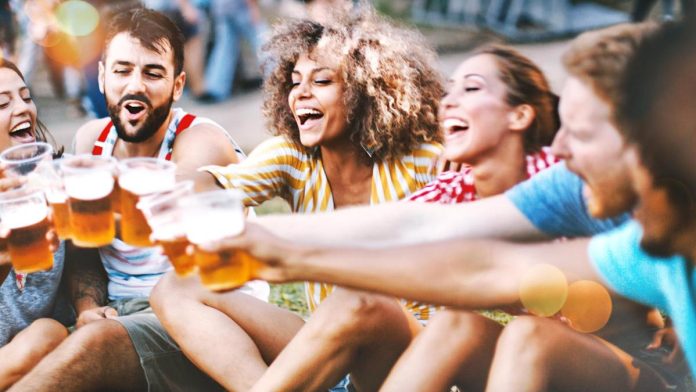Beer has to rotate – that was back in the day. For some time now, the brewing industry has been experiencing a remarkable turn to alcohol-free barley drinks. And the demand continues to grow. Opinions differ on the question of whether beer is also suitable as a sports drink.
One type of beer follows another in the beverage market. Until a few years ago, it was the alcoholic beers that took up most of the shelf space, but now the non-alcoholic beers and mixed beer drinks have often moved to the front row. Gone are the days when beer without revolutions – often spurned as an emergency solution for drivers – led a shadowy existence.
Nothing there: non-alcoholic beer is drunk on all occasions today – at lunchtime business lunches as well as at summer barbecues. More and more recreational athletes have also discovered barley juice without alcohol to replenish their energy stores after physical activity. Opinions differ as to whether this is the best choice. The German Brewers Association has now gotten to the bottom of this.
Soon every tenth beer will be alcohol-free
“Non-alcoholic beers now make up seven percent of the market. We expect that soon every tenth beer brewed in Germany will be alcohol-free,” explains Holger Eichele, head of the German Brewers Association. “We have been experiencing a real non-alcoholic boom since 2008,” says Uwe Albershardt, Managing Director of Sales at the Haus Cramer Group (Warsteiner), and backs this up with figures: after decades of sales languishing at around 2.3 million hectoliters per year In 2010 it was already 4.3 million hectoliters. “And over the next ten years, sales of non-alcoholic beer grew by 53 percent to 6.7 million hectoliters in 2020,” says Albershardt. The trend continues to rise.
“There will be no way around this trend in the future,” Angelika Thielen is convinced. She heads corporate communications at Bitburger Braugruppe, the market leader for 0.0% beers. The development there was recognized very early, says Thielen. In 2013, Bitburger was the first large brewery in Germany to bring a 0.0% beer onto the market that is both isotonic and vitamin-rich. “More non-alcoholic beers and mixed beer drinks will come onto the market in the future,” predicts Angelika Thielen. One reason for this is that “end consumers are becoming more and more involved with food and attach great importance to a conscious diet.”
Non-alcoholic beer is an alternative to sugary soft drinks. After all, the Purity Law guarantees the exclusive use of natural raw materials. Due to strong demand, breweries have significantly increased their range of non-alcoholic beers – and continue to do so. “At least one new beer comes onto the market every week,” estimates Holger Eichele. “Alcohol-free shandy with lemon and other fruits” is becoming increasingly popular.
Uwe Albershardt can only agree with this: Just last year, the Sauerlanders released the Warsteiner Natur-Radler Lemon Alcohol-Free 0.0% and this spring they followed up again with the NaturRadler Grapefruit Alcohol-Free 0.0% – because the naturally cloudy Radler in particular have proven to be a promising category in the beer industry, explains Warsteiner marketing director Lasse Thiele.
And it's not just the diversity that is getting bigger and bigger. The taste of non-alcoholic beers has also gotten better over the years. In the current test by Stiftung Warentest (test 06/2024), five non-alcoholic beers achieved a sensory rating of 2.0. Overall, in the analysis of 20 non-alcoholic beers, twelve scored “good”, seven received a “satisfactory” rating and only one had to be satisfied with a “sufficient”. “From our point of view, a very positive result,” says Holger Eichele.
There is only one point where the product testers do not agree with the head of the Brewers' Association. From their point of view, non-alcoholic beers are not an ideal sports drink. According to Stiftung Warentest, even the isotonic beers have “too little sodium to compensate for sweated out salt and too much potassium, which can reduce performance” for a sports drink. But: “The German Institute for Sports Nutrition comes to completely different results here,” emphasizes Eichele.
The central statement of the Bad Nauheim-based institute, abbreviated DiSE: They are convinced of alcohol-free beer for effective regeneration after sport. The brochure literally says “Alcohol-free beer. A refreshing thirst quencher for effective regeneration after sport”, which has just been published: “With non-alcoholic beer, fitness, leisure and recreational athletes receive a drink that is suitable for the regeneration phase, especially after activities of one hour or more, as well as for enjoyment can be recommended between two sporting activities.”
The non-alcoholic beer is often isotonic, so it supports quick water replacement and enables “energy stores to be replenished in a sport-friendly manner”. It replaces electrolytes such as potassium and magnesium that are lost through sweat during exercise. The body needs potassium so that the muscles can tense and relax. After physical activity, an intake of potassium is necessary for regeneration, emphasizes the DiSE. It literally says: “Potassium is stored in the liver and muscles together with the storage form of carbohydrates, glycogen. Approximately 19 mg of potassium is required per gram of glycogen. In order to replenish completely depleted glycogen stores of around 400 g in well-trained endurance athletes, approximately eight grams of potassium are necessary!”
This can hardly be achieved “if we don’t specifically include foods rich in potassium, such as: B. non-alcoholic beers can be included in nutritional management.” In addition, the non-alcoholic beer supplies the vitamins B6, B9 and B12, which are important for energy metabolism, and can “effectively contribute to covering the general and sports-related additional needs of these vitamins”.
The brochure was created in collaboration between DiSE and the German Brauer Association with the aim of providing information on proper drinking in the context of “sport”, which is based on current scientific data. The DiSE points out that the information “is presented objectively and balanced, regardless of the financing”.


